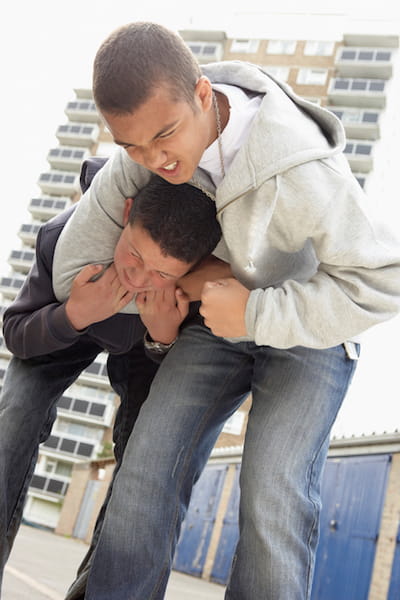Finding out that your child is harming themselves can be shocking, confusing and concerning. Often, parents react in a way that make things worse for the child and the family in general. Given the complexity and importance of this topic, we’ll talk about it in three separate blog posts. In this first post, we’ll discuss ways in which teens may self-harm. Second, we’ll look at contributing factors and reasons why they do it. Lastly, we’ll talk about common red flags and practical exercises to help teens who are struggling. Understanding the contributing factors will help you make adjustments to the “big picture” instead of assuming that all the responsibility lies with the child. The practical exercises are based on the reasons why they do it because teens self-harm for different reasons. Therefore, you have to make sure you match the exercise appropriately.
What does it mean for a teen to self-harm?
Let me first distinguish between self-harming behavior and suicidal behavior. Suicidal behavior is an intentional, planned attempt to end one’s life. Self-harming behavior is a coping mechanism ironically used to be able to live despite the emotional pain. In other words, the intention of suicide is to end one’s life whereas the intention of self-harm is to continue one’s life. Self-harming behavior is used to manage sensations, images, feelings, and thoughts often related to a traumatic event. To add further clarification, a traumatic event is not just an event where one’s life is threatened, but it can also be an event or series of events where the child’s mind and body felt overwhelmed and did not have a way to release the emotions and sensations.
There are many examples of self-harming behaviors. Some of these include:
As the name implies, this is when a teen inflicts physical pain to him or herself. It includes such behaviors as using sharp objects to create wounds on the wrist, palms, shoulders, underarms, stomach, thighs, legs, etc. It also includes carving, pinching, pulling hair, burning skin, picking at skin, severe scratching, banging head, hitting self, interfering with wound healing, and rubbing skin against rough surfaces. Under these circumstances, the body releases endorphins, which are natural pain killers. In doing so, the body creates a sort of numbing sensation that often helps teens cope with emotional pain.

This is another form of self-harming where the teens leaves the home for extended periods of time, often right after an argument or when they are triggered. Running away gives them a sense of independence and control over their decisions. If they do it because they are triggered, it gives them a chance to be away from a reminder of something bad that happened to them.
This includes promiscuity and using sex as a way to have more control. Although not always, poor sexual boundaries are often associated with a history of sexual abuse. The teen has come to believe that sex does not have any value other than control. Therefore, the teens now use it on his or her terms. This provides a sense of power and control over something bad that happened to her or him.
This is related to the previous one but sexting is seen as “safer” since there is no physical contact with the recipient. Sexting provides the teen with attention, affirmation, and a sense of power and control. It also provides a natural “high” due to the risks involved. All of this makes it difficult for the teen to weigh the pros and cons and often disregards the risks.
The issue with abusive relationships for teens is not that they happen but that teens choose to remain in the relationship. Being in an abusive relationship gives them a false sense of security, often because their self-esteem is so low that they do not believe they could find someone else. They would rather be with someone, even if he or she is not healthy for them, than to be alone. Loneliness often intensifies the emotions they are trying to avoid.
-
Medication non-compliance
Teens may choose not to take their necessary medications as a way to avoid leaving their home and/or their room. This may be their way of maintaining a secure and safe environment by causing their illness to last longer. This keeps them away from whatever is or has caused pain. In those who are being sexually abused, remaining sick is often their way of keeping the perpetrator away.

Like many adults, teens use and abuse drugs and alcohol as a way to cope with emotional issues. It is often wrong to think that it will be more difficult for teens to have access to drugs and alcohol. The reality is that it is very likely that your teen has been offered drugs at school or that he or she knows people who use drugs. Although these drugs do include illegal drugs, they can also include medications that were stolen from caregivers.
The two most common eating problems are anorexia nervosa and bulimia. Both often are borne out of the necessity to have a sense of control and because of an injured sense of self. Food becomes the means to externalize the pain.
When teens plan to get pregnant, they often do it with the idea that having someone dependent on them will make them feel more powerful. Other times they just want someone to love and love them back unconditionally. This need for love makes them focus on the good things about having a baby and disregard all of the responsibilities associated with having a baby. This is under self-harming behaviors because teens do not have the physical, emotional, and cognitive maturity to properly take care of a baby. Having a a baby often hinders their school and career options, but for them, having someone to love and care for overrides the price they will pay for it.
Let’s face it, going to school is not most teens’ favorite thing to do. They will often come up with excuses to avoid having to go to school. However, many teens avoid school because of reminders of past traumas, bullies, or because they’ve given up on their future. Teens that were victims of a crime often avoid going to school because they cannot stand being looked at by others and being reminded of what happened to them. Unfortunately, gossiping is common among teens so this makes it more difficult. This is often made worse when social media is used and the teen knows that many people at school know about the crime. Teens rely heavily on others’ view of them to create a sense of worth and identity. Therefore, it is not surprising that they use school truancy to essentially ignore and stay away from the school life. In the case of giving up on their future, if teens have experienced difficult events in their families such as losing someone valuable to them, constantly moving, separation/divorce, or emotional neglect, they may assume that going to school is pointless. They have come to conclude that any effort is useless so going to school becomes a reminder of what they cannot have. Seeing other students succeed makes their perceived reality more difficult to bear.

This form of self-harming behavior can often be seen due to two reasons. One reason is that fighting becomes their way to externalize anger, hurt, and disappointment. Another reason is if they feel ashamed, and guilty, fighting becomes their way of punishing themselves.
-
Meeting online people in person
Establishing any form of relationship that is perceived as meaningful is a human need. Unfortunately, social media is becoming a common avenue to meet others with the intention of forming a romantic relationship. When teens feel the lack of these connections in their real lives, they will gravitate towards an online life where they can be more open and vulnerable due to the perceived sense of control. These online relationships can often become so important to teens that they are willing to take risks in an effort to keep those relationships.
As you can see, self-harming behaviors are not just those that involve self-injury but many others that will have an impact in the teen’s life. Understanding what these different ways are gives us a wider look at the many ways our own teens can potentially self-harm. In our next blog post on this topic, we’ll talk about the different factors that contribute to this behavior so that you’ll understand what leads teens to choose one or more self-harming behaviors rather than ask for help and have a conversation with a trusted adult.
 This is another form of self-harming where the teens leaves the home for extended periods of time, often right after an argument or when they are triggered. Running away gives them a sense of independence and control over their decisions. If they do it because they are triggered, it gives them a chance to be away from a reminder of something bad that happened to them.
This is another form of self-harming where the teens leaves the home for extended periods of time, often right after an argument or when they are triggered. Running away gives them a sense of independence and control over their decisions. If they do it because they are triggered, it gives them a chance to be away from a reminder of something bad that happened to them.  Like many adults, teens use and abuse drugs and alcohol as a way to cope with emotional issues. It is often wrong to think that it will be more difficult for teens to have access to drugs and alcohol. The reality is that it is very likely that your teen has been offered drugs at school or that he or she knows people who use drugs. Although these drugs do include illegal drugs, they can also include medications that were stolen from caregivers.
Like many adults, teens use and abuse drugs and alcohol as a way to cope with emotional issues. It is often wrong to think that it will be more difficult for teens to have access to drugs and alcohol. The reality is that it is very likely that your teen has been offered drugs at school or that he or she knows people who use drugs. Although these drugs do include illegal drugs, they can also include medications that were stolen from caregivers.  This form of self-harming behavior can often be seen due to two reasons. One reason is that fighting becomes their way to externalize anger, hurt, and disappointment. Another reason is if they feel ashamed, and guilty, fighting becomes their way of punishing themselves.
This form of self-harming behavior can often be seen due to two reasons. One reason is that fighting becomes their way to externalize anger, hurt, and disappointment. Another reason is if they feel ashamed, and guilty, fighting becomes their way of punishing themselves. 





